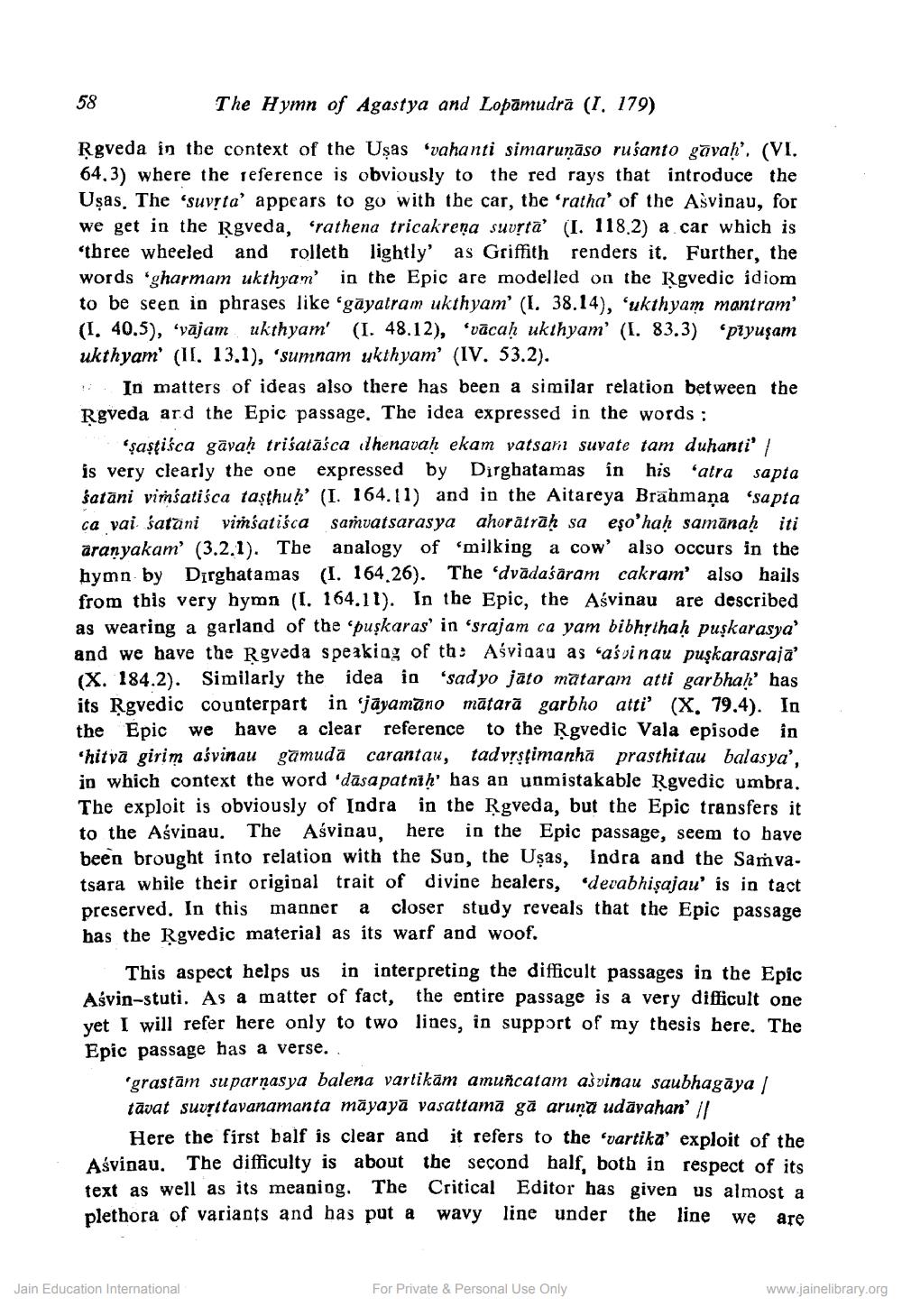________________
58
The Hymn of Agastya and Lopamudra (I. 179)
Rgveda in the context of the Ușas 'vahanti simaruṇāso rusanto gāvaḥ'. (VI. 64.3) where the reference is obviously to the red rays that introduce the Usas. The 'suvṛta' appears to go with the car, the 'ratha' of the Asvinau, for we get in the Rgveda, rathena tricakrena suvṛta' (I. 118.2) a car which is "three wheeled and rolleth lightly' as Griffith renders it. Further, the words 'gharmam ukthyam' in the Epic are modelled on the Rgvedic idiom to be seen in phrases like 'gayatram ukthyam' (I. 38.14), 'ukthyam mantram' (I. 40.5), 'vājam ukthyam' (I. 48.12), vācaḥ ukthyam' (I. 83.3) piyuşam ukthyam' (II. 13.1), 'sumnam ukthyam' (IV. 53.2).
In matters of ideas also there has been a similar relation between the Rgveda ard the Epic passage. The idea expressed in the words:
şaştisca gavaḥ trisatasca dhenavaḥ ekam vatsam suvate tam duhanti' | is very clearly the one expressed by Dirghatamas în his 'atra sapta satani vimsatisca tasthuḥ' (I. 164.11) and in the Aitareya Brahmaņa sapta ca vai satani vimsatisca samvatsarasya ahorātrāḥ sa eşo'haḥ samanaḥ iti aranyakam' (3.2.1). The analogy of milking a cow' also occurs in the hymn by Dirghatamas (I. 164.26). The 'dvadaśaram cakram' also hails from this very hymn (I. 164.11). In the Epic, the Aśvinau are described as wearing a garland of the 'puşkaras' in 'srajam ca yam bibhṛthaḥ puşkarasya' and we have the Ṛgveda speaking of the Aśvinau as aśvinau puskarasraja' (X. 184.2). Similarly the idea in 'sadyo jato mataram atti garbhaḥ' has its Ṛgvedic counterpart in 'jāyamāno mātarā garbho atti' (X. 79.4). In the Epic we have a clear reference to the Rgvedic Vala episode in 'hitvā girim aśvinau gamuda carantau, tadvṛṣṭimanha prasthitau balasya', in which context the word 'dāsapatnīḥ' has an unmistakable Rgvedic umbra. The exploit is obviously of Indra in the Rgveda, but the Epic transfers it to the Aśvinau. The Aśvinau, here in the Epic passage, seem to have been brought into relation with the Sun, the Uṣas, Indra and the Samvatsara while their original trait of divine healers, devabhişajau' is in tact preserved. In this closer study reveals that the Epic passage has the Rgvedic material as its warf and woof.
manner a
This aspect helps us in interpreting the difficult passages in the Epic Aśvin-stuti. As a matter of fact, the entire passage is a very difficult one yet I will refer here only to two lines, in support of my thesis here. The Epic passage has a verse..
'grastām suparnasya balena vartikām amuñcatam aśvinau saubhagāya | tāvat suvṛttavanamanta māyayā vasattamā gā aruṇā udāvahan' ||
Here the first half is clear and it refers to the "vartika' exploit of the Aśvinau. The difficulty is about the second half, both in respect of its text as well as its meaning. The Critical Editor has given us almost a plethora of variants and has wavy line under the line we are
put a
Jain Education International
For Private & Personal Use Only
www.jainelibrary.org




